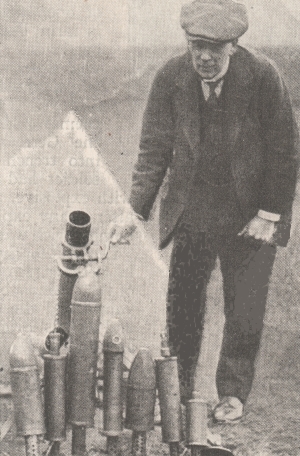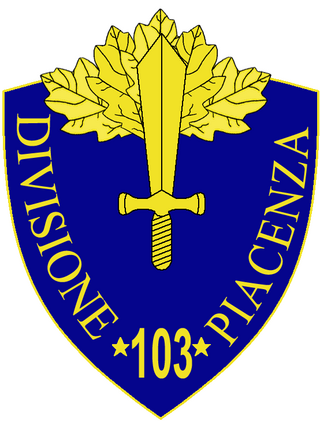
The Canon d'Infanterie de 37 modèle 1916 TRP was a French infantry support gun, first used during World War I. TRP stands for tir rapide, Puteaux. The tactical purpose of this gun was the destruction of machine gun nests.

A mortar is usually a simple, lightweight, man-portable, muzzle-loaded weapon, consisting of a smooth-bore metal tube fixed to a base plate with a lightweight bipod mount and a sight. They launch explosive shells in high-arcing ballistic trajectories. Mortars are typically used as indirect fire weapons for close fire support with a variety of ammunition.

The Brixia Model 35 was an Italian small-sized, rapid firing light mortar of World War II. The Brixia Modello 35 was used to provide light supporting fire to the infantry companies. It was issued at battalion level, with each battalion containing nine mortars and these were parceled out to each infantry company. It had a good rate of fire but lacked power due to the small round. It was widely used and saw action on every major Italian front.

The Type 97 81 mm infantry mortar was a Japanese mortar used primary by Imperial Japanese Army during World War II. The Type 97 designation was given to this gun as it was accepted in the year 2597 of the Japanese calendar (1937). It entered service in 1937. Japanese infantry units often are equipped with 81-mm mortars. The Type 97 81 mm mortar is very commonly used and is referred to by the Japanese as an "Infantry Gun", which breaks down into 3 sections for transport. The markings which appear on the base of the barrel read "97 model small trench mortar."

The M1 mortar is an American 81 millimeter caliber mortar. It was based on the French Brandt mortar. The M1 mortar was used from before World War II until the 1950s when it was replaced by the lighter and longer ranged M29 mortar.

An 81-mm mortar is a medium-weight mortar. It is a smooth-bore, muzzle-loading, high-angle-of-fire weapon used for long-range indirect fire support of light infantry, air assault, and airborne units across the entire front of a battalion zone of influence.

The M2 Mortar is a 60 millimeter smoothbore, muzzle-loading, high-angle-of-fire weapon used by U.S. forces in World War II, the Korean War, and the Vietnam War for light infantry support.

The Stokes mortar was a British trench mortar designed by Sir Wilfred Stokes KBE that was issued to the British and U.S. armies, as well as the Portuguese Expeditionary Corps, during the latter half of the First World War. The 3-inch trench mortar is a smooth-bore, muzzle-loading weapon for high angles of fire. Although it is called a 3-inch mortar, its bore is actually 3.2 inches or 81 mm.

The 29th Infantry Division "Piemonte" was an infantry division of the Royal Italian Army during World War II. The division was garrisoned in Messina on Sicily and recruited primarily on the island. The division was in Greece when the Armistice of Cassibile was announced on 8 September 1943 and dissolved by German forces three days later.

The Brandt mle 27/31 mortar was a regulation weapon of the French army during the Second World War. Designed by Edgar Brandt, it was a refinement of the Stokes mortar. The Brandt mortar was highly influential, being licensed built or copied by numerous countries.

The Type 97 90 mm infantry mortar was a simplified version of the Japanese Type 94 90 mm Infantry Mortar. The Type 97 designation was given to this gun as it was accepted in the year 2597 of the Japanese calendar (1937).

81 KRH 71 Y is a light mortar manufactured by Tampella for use by the Finnish Army. It is usually used to support the infantry by indirect fire, but it can also be used for direct fire. Each Finnish infantry company has a platoon of 81 mm mortars. The mortar platoon consists of three seven-man mortar squads, each squad manning a single 81 mm mortar. Jaeger Company M2005 has a fire support squad, which consists of two five-man mortar teams, both equipped with an 81 mm mortar. It can fire HE-fragmentation, smoke, illumination and practice rounds.

The 10 cm Nebelwerfer 35 was a heavy mortar used by Germany during World War II. Much like the American M2 4.2 inch mortar it was intended to deliver chemical munitions, such as gas and smoke shells. Unlike the American weapon it appears to have had an ordinary high-explosive shell from the beginning. It was of conventional design, and was virtually a scaled-up 8 cm GrW 34. It broke down into the standard three loads for transport. The tube weighed 31.7 kg (70 lb), the baseplate 36.3 kg (80 lb) and the bipod 32.2 kg (71 lb). Each could be man-packed for some distance, but small handcarts were issued for longer distances. Each mortar squad consisted of a squad leader, three gunners and three ammunition bearers.

The 103rd Infantry Division "Piacenza" was an infantry division of the Royal Italian Army during World War II. The Piacenza was named for the city of Piacenza and classified as an auto-transportable division, meaning it had some motorized transport, but not enough to move the entire division at once.

The 105th Infantry Division "Rovigo" was an infantry division of the Royal Italian Army during World War II. The Rovigo was named for the city of Rovigo and classified as an auto-transportable division, meaning it had some motorized transport, but not enough to move the entire division at once.

The 50th Infantry Division "Regina" was an infantry division of the Royal Italian Army during World War II. The Regina was formed on 1 March 1939 in the Italian Islands of the Aegean and entitled to the Queen. After the announcement of the Armistice of Cassibile between Italy and the Allies on 8 September 1943 the division fought Wehrmacht forces in the Battle of Rhodes. The majority of the division surrendered on 11 September 1943, while the III Battalion, 10th Infantry Regiment "Regina" resisted the Germans on Leros until 16 November 1943.

The 120 KRH 92 is a 120 mm mortar manufactured in Finland.

120 Krh/40 is a 120 mm mortar developed by the Finnish company Tampella.

The Cannon 76/40 Model 1916 was a widely used naval gun on ships of the Royal Italian Navy during World War I and World War II. A very versatile weapon it was used as primary, secondary and tertiary armament on a number of ship classes. After being replaced aboard ships of the Royal Italian Navy it saw widespread use on land in a number of different roles such as coastal artillery, anti-aircraft gun and railroad gun during World War II.

The 3.7 cm Infanteriegeschütz M.15 was an Austro-Hungarian cannon developed for use in the trenches during the First World War. The name indicates the caliber in centimeters, the gun's role Infanteriegeschütz which in German means infantry support gun and the model according to the year of introduction. Captured Austrian guns and Italian produced copies were first designated Cannon 37F and later as 37/10 F. Mod. 1915 in the 1930s.




















